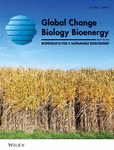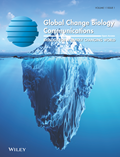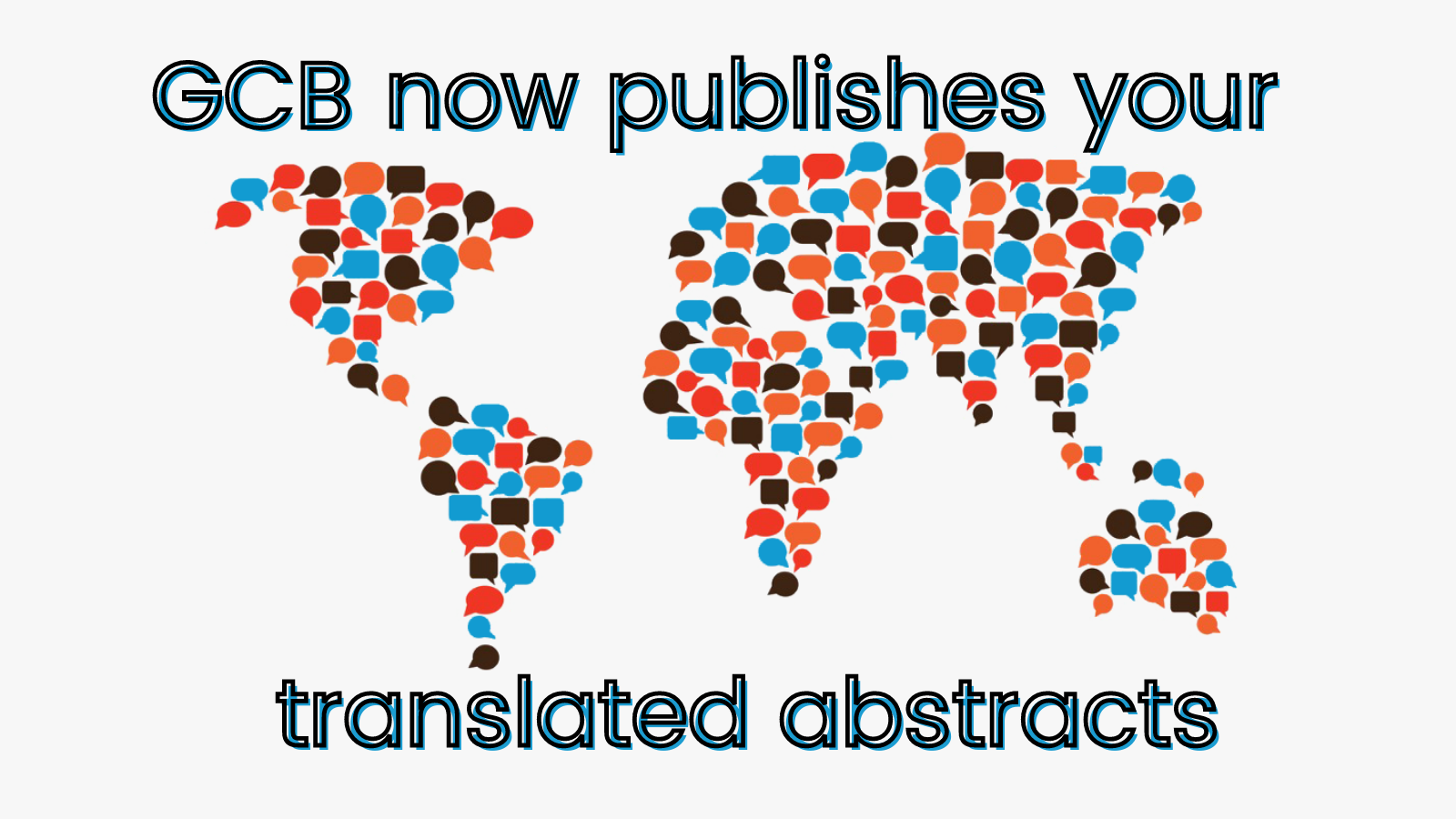Journal list menu
Export Citations
Download PDFs
ISSUE INFORMATION
COMMENTARY
What are small-size microplastic distributions telling us?
- Pages: 2843-2845
- First Published: 16 February 2022

Writing in this issue of Global Change Biology, Shiye Zhao and co-authors report a microplastic soup extending thousands of meters below the South Atlantic Subtropical Gyre. This discovery contributes two pieces to the missing plastic puzzle- (1) nets have been under-sampling the smallest microplastic size fraction, which is actually not missing when using high-volume filtration, and (2) small microplastics in particular find their way below the surface. But their results also contribute several new questions, because some of what they found is quite surprising.
This article is a Research Article on Zhao et al., https://doi.org/10.1111/gcb.16089.
INVITED REVIEW
Actions to halt biodiversity loss generally benefit the climate
- Pages: 2846-2874
- First Published: 31 January 2022

This review provides evidence that biodiversity conservation actions have mostly synergistic benefits and few antagonistic trade-offs with climate change mitigation. Specifically, we identify co-benefits in 14 out of the 21 action targets of the draft post-2020 global biodiversity framework of the Convention on Biological Diversity. These relationships are context- and scale-dependent; therefore, based on 12 case studies in different parts of the world, we showcase local biodiversity conservation actions that can be incentivized, guided and prioritized by global objectives and targets. We highlight the close interlinkages between biodiversity, climate change mitigation, other nature's contributions to people and good quality of life which need to be better integrated in management and policy.
REVIEW
The impact of mobile demersal fishing on carbon storage in seabed sediments
- Pages: 2875-2894
- First Published: 17 February 2022

Subtidal marine sediments are one of the planet's primary carbon stores and strongly influence the oceanic sink for atmospheric CO2. Considering basic principles, we hypothesize that under certain environmental settings, trawling/dredging for fish and shellfish would reduce seabed sediment carbon storage; however, this may be offset by positive feedback mechanisms in some circumstances. A review of studies which directly investigated this impact in situ also highlighted mixed results. More evidence is urgently needed to accurately quantify this impact in different environmental settings, and incorporate full evidence-based carbon considerations into global seabed management.
RESEARCH ARTICLES
Demographic composition, not demographic diversity, predicts biomass and turnover across temperate and tropical forests
- Pages: 2895-2909
- First Published: 25 January 2022

(a) We fit growth and survival models to 1,961 species across 20 tropical and temperate forest plots. (b) Species were clustered into Growth-Survival-Stature Modes (GSSMs) based on demographic rates. At each plot we calculated demographic diversity (DD) as the area occupied by species in demographic space, and demographic composition (DC) as the relative abundance of each GSSM. (c) DD peaks at intermediate levels of species richness. (d) Aboveground biomass (AGB) and carbon residence time are not related to DD across plots, but are related to DC, specifically the relative abundance of high-survival, large-statured GSSMs 5 and 6.
Does growing atmospheric CO2 explain increasing carbon sink in a boreal coniferous forest?
- Pages: 2910-2929
- First Published: 03 February 2022

Trends and inter-annual variability of carbon and water exchange of a boreal coniferous-dominated forest in southern Finland was studied by combining 17 years eddy-covariance data with process-model scenarios. We found increase of net carbon sink (+6.4–7.0 gC m−2 a−1) but no change in evapotranspiration. The increasing gross-primary productivity was mostly attributed to management-stimulated leaf-area increase, not atmospheric CO2 fertilization. Meteorological conditions created strong inter-annual variability but did not contribute to decadal trends.
Hydroclimatic adaptation critical to the resilience of tropical forests
- Pages: 2930-2939
- First Published: 31 January 2022

With the availability of longer time series of remotely sensed datasets, our study tries to incorporate far overlooked temporal support in determining the transient ecosystems’ state and resilience across time. Here, we use the last 20 years of remote sensing data to provide empirical (spatio-temporal) evidence to alternative stable states and the influence of hydroclimatic adaptation dynamics in maintaining these transient states. Our results also show that ignoring this adaptive capacity can largely underestimate the resilience of the forest ecosystems. Moreover, spatially explicit mapping of these transient states can help strengthen conservation and management efforts.
Surface temperatures reveal the patterns of vegetation water stress and their environmental drivers across the tropical Americas
- Pages: 2940-2955
- First Published: 24 February 2022

We developed a new methodology to improve our understanding of vegetation water stress, based on remotely sensed land surface and near surface atmospheric temperatures and applied it in the tropical Americas. We showed where radiation, atmospheric dryness, and precipitation control variations of water stress, pinpointed critical thresholds for water stress, and quantified reductions in ecosystem carbon uptake associated with crossing these critical thresholds. We found that carbon uptake by gross primary production can be reduced by up to 80% from water stress, and demonstrate that vegetation structure and diversity can be important for regulating surface energy and carbon fluxes.
Satellite data reveal differential responses of Swiss forests to unprecedented 2018 drought
- Pages: 2956-2978
- First Published: 19 February 2022

We use the change of the normalized difference water index (NDWI) to detect which forest areas were damaged by the 2018 drought in Switzerland, and the conditions that lead to these effects. We found strongest linear relations between damaged forest and folded aspect, distance to the forest edge, elevation, and forest type. However, the direction and strength of the relationship varied based on the underlying time frame.
Deep demersal fish communities respond rapidly to warming in a frontal region between Arctic and Atlantic waters
- Pages: 2979-2990
- First Published: 23 February 2022
Large quantities of small microplastics permeate the surface ocean to abyssal depths in the South Atlantic Gyre
- Pages: 2991-3006
- First Published: 19 January 2022

The depth distribution of plastics in the subtropical gyres remains unclear. Here, we observed high quantities of small microplastics (SMPs, <100 μm) from surface to abyssal waters of the South Atlantic Gyre. SMPs with presumably slower sinking rates are less influenced by density gradients, thus resulting in a more even vertical distribution in the water column, and potentially longer residence times. SMP hotspots form at depth, low current-flow regimes, implying a higher encounter rate for subsurface particle feeders. Our findings highlight SMP is a vital component in ocean plastic inventories and worthy of more research efforts.
see also the Commentary: https://doi.org/10.1111/gcb.16129.
Rapid evolution fuels transcriptional plasticity to ocean acidification
- Pages: 3007-3022
- First Published: 03 March 2022

Elevated pCO2 induced common molecular responses related to circadian rhythm and immune system but different magnitudes of response across six species. Acanthochromis polyacanthus exhibited many more differentially expressed genes with a more rapid evolutionary rate fuelling the increased transcriptional plasticity
Coupled changes in pH, temperature, and dissolved oxygen impact the physiology and ecology of herbivorous kelp forest grazers
- Pages: 3023-3039
- First Published: 08 February 2022

Understanding species’ responses to upwelling may be especially important in light of ongoing environmental change. Here, we test the effects of acute (0–3 days) and chronic (1–3 month) upwelling on the performance of two species of kelp forest grazers, the echinoderm, Mesocentrotus franciscanus, and the gastropod, Promartynia pulligo. Results indicate current exposure to upwelling may reduce species performance and predicted future increases in upwelling frequency and intensity could affect ecosystem function by modifying the ecological roles of key species.
Staying in place and moving in space: Contrasting larval thermal sensitivity explains distributional changes of sympatric sea urchin species to habitat warming
- Pages: 3040-3053
- First Published: 02 February 2022

Two sea urchin species, Centrostephanus rodgersii and Heliocidaris tuberculata, sympatric in the East Australia Current warming hotspot, exhibit contrasting responses to regional warming. C. rodgersii has range extended to Tasmania and continues to thrive in its main range due to its broad cold-warm larval thermal tolerance. In contrast, H. tuberculata has stayed in place restricted by the cold intolerance of its larvae and this will delay its poleward extension as the region warms. In a warming ocean we show that intrinsic thermal biology traits of the pelagic stage provide an integrative tool to explain species-specific variation in range shift patterns.
Multi-decadal environmental change in the Barents Sea recorded by seal teeth
- Pages: 3054-3065
- First Published: 24 February 2022

Bottom-up relative to top-down control has been predicted to increase in Arctic food webs. Detecting changes and determining their drivers at the base of the Arctic food web is therefore crucial for forecasting food web dynamics. Combining stable nitrogen isotopes (δ15N) of phenylalanine from archived teeth of harp seals, and results from an ocean-biogeochemical model, we show a 60-year decline of δ15N values at the base of the Barents Sea food web, driven by anthropogenic atmospheric nitrogen deposition in the Atlantic, increased northward transport of Atlantic water through Arctic gateways and local feedbacks from increasing Arctic primary production.
RESEARCH REPORT
MASTREE+: Time-series of plant reproductive effort from six continents
- Pages: 3066-3082
- First Published: 16 February 2022

MASTREE+ is an open-access data set that collates reproductive time-series data from across the globe. It includes 73,828 georeferenced observations of annual reproduction (e.g. seed and fruit counts) in perennial plant populations, consisting of 5,971 population-level time-series from 974 species. MASTREE+ will provide the basis for improved understanding of the response of plant reproduction to environmental change and can be used to investigate the ecology and evolution of plant reproductive strategies and the role of plant reproduction as a driver of ecosystem dynamics.
RESEARCH ARTICLES
No evidence for a negative effect of growing season photosynthesis on leaf senescence timing
- Pages: 3083-3093
- First Published: 17 February 2022

Despite the importance of changes in ecosystem phenology, the mechanisms that control the end of the growing season (EOS) in most ecosystems remain poorly understood. Recently, a hypothesis suggesting that more productive growing seasons lead to an earlier EOS has been proposed. In the present study, we used 40 eddy-covariance flux tower observations to test the relationship between growing season photosynthesis and end of season senescence. Our results indicated that more productive growing seasons were typically related to a later, not earlier, EOS.
Diverging patterns at the forest edge: Soil respiration dynamics of fragmented forests in urban and rural areas
- Pages: 3094-3109
- First Published: 15 February 2022

As global urbanization and forest fragmentation increase, it is critical to understand how rates of carbon losses from soil carbon pools will be affected. While previous studies found increased temperatures at rural forest edges could lead to elevated soil respiration rates, we observed that in urban areas soil respiration rates were suppressed at the forest edge relative to the interior, likely due to heat and water stress. This suggests that failure to account for soil respiration rates near the edge leads to substantial errors in biogenic carbon estimates and highlights the need to capture the effects of forest fragmentation and urbanization context when making future projections.
Global maps of soil temperature
- Pages: 3110-3144
- First Published: 29 December 2021

We provide global maps of soil temperature at a 1 km2 resolution, based on a global database of more than 8500 in situ soil temperature time series. We show that over the year, soils in cold and/or dry biomes are on average 3.6°C warmer, whereas soils in warm and humid environments are 0.7°C cooler than gridded air temperature.
Soil fauna drives vertical redistribution of soil organic carbon in a long-term irrigated dry pine forest
- Pages: 3145-3160
- First Published: 05 February 2022

Although essential for C incorporation into the soil, the role of soil fauna in SOC cycling of dry forests has largely been overlooked. Here, we show that 17-year-long irrigation in a naturally dry pine forest led to C losses from organic layers and comparable C gains in uppermost mineral soils. The vertical SOC redistribution was mainly driven by accelerated faunal-mediated litter incorporation. Our findings reveal that soil fauna is highly sensitive to natural drought, which affects the C transfer into the mineral soil. In the longer term, this will lead to potential cascading effects on SOC storage and stability.









